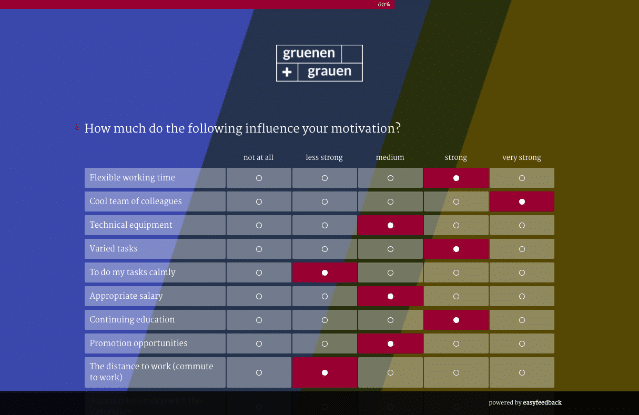What makes your employees happy?
Employee satisfaction is made up of a variety of elements that combine to create an employee’s mood toward their job. These include various factors depending on the job profile – at their core, they include the following:
- Satisfaction with one’s own job
- Satisfaction with the social environment in the company
- Satisfaction with the job compared to others
The following always applies: Understand the needs of your employees in order to use them as motivators. There are various theories in research that help you to understand which needs your employees have.
Satisfied employees have several advantages for your company. However, a major sticking point is dissatisfied employees. Digitalization has increased the prevalence of negative feedback.
There are a large number of job portals on the web where people not only exchange information about salary and working hours, but also about personal experiences with the employer.
This ultimately leads to dissatisfied employees also communicating their negative experiences to potential applicants. So that you don’t have to wait until the next post on one of these portals to find out, it’s worth measuring employee satisfaction in advance and taking action.
The two-factor theory
This states that two different types of factors influence the degree of motivation:
- The content of the activity, the motivators.
- The work environment, the hygiene factors.
However, these differ fundamentally.
The motivators
Motivators are the direct influences on the work itself. These include:
- Responsibility
- Competence building
- Opportunities for advancement
- Recognition
- Successes
If these factors are satisfactory, they will lead to employee satisfaction. If they are not, this does not make your employees directly dissatisfied, but simply less motivated.
The hygiene factors
The hygiene factors, on the other hand, do not concern the work itself, but external factors such as:
- Salary
- Management style
- Work-life balance
- Culture
- Personal relationships with colleagues and managers
Your employees take them for granted. If these requirements are not sufficiently met for your employees, this will lead to dissatisfaction in the workforce.
On the contrary, if they are present, your employees will have no complaints, but they will not be more motivated by them alone.
This means in practice:
No matter how exciting the job, if your employees don’t get along with each other, work overtime like crazy and are completely underpaid, you won’t be able to avoid dissatisfaction in the long term, even if they are highly motivated and enthusiastic about the job.
In contrast, if you have an employee with a less exciting job profile and few opportunities for advancement, you may not be able to motivate them with a higher salary and more flexible work hours, but you can reduce discomfort.
So always look at the needs and motivations of employees in combination to correctly interpret dissatisfaction and find the appropriate levers.
Employee satisfaction and Maslow’s pyramid of needs
Maslow’s well-known pyramid of needs arranges a person’s needs according to a hierarchy. The lowest level represents the most urgent needs.
Once the needs of one level of the hierarchy have been satisfied, the person feels the need to satisfy the needs of the next higher level.

- Physiological needs: These include a person’s basic needs, such as the need for food, water, and sleep.
- Security needs: The need for secure housing, future security, and maintaining one’s own health, as well as that of one’s family.
- Social needs: These are the needs for belonging, a partner, family and friends, and affection and closeness.
- Individual needs: These include the need for recognition, praise, and trust.
- Self-actualization: These are needs for the development of the personality, such as playing a musical instrument, pursuing a hobby, living out creativity, and discovering one’s own talent.
Reflected on the world of work, this results in the following needs and levels:
- Basic needs remain unchanged.
- In the world of work, security needs are the need for a secure job or the need for a permanent employment relationship with an appropriate salary that guarantees the maintenance of one’s apartment or house. The job must not endanger health.
- The social needs describe working in a pleasant team and working environment. Of course, the environment varies depending on the job profile. If your employees are in contact with customers a lot, they also count as part of the social environment. The work-life balance also plays a major role, because if you earn a lot and have a secure job, but never get to see your children because of your working hours, you will feel motivated to change this.
- Individual needs now play one of the most important roles for employees. Praise, appreciation and the recognition of managers, colleagues and the company play a major role here. But trust and independence are also a factor here.
- The last and thus highest level of needs in the working world is the need for self-actualization. The development of one’s own talent, towards expert status or to the top of the corporate hierarchy.
In practice, you will experience the following:
If your employee has a temporary contract and a low salary, no matter how much praise and recognition you give him, he will not be satisfied in his position in the long run. Likewise, if your employees secretly fear for their jobs, there will be no good mood at sports activities on your team development.
As our labor market has fundamentally changed to an employee market in recent years, the level of individual needs has already been reached for many employees and should definitely not be disregarded.
How to measure employee satisfaction
The most important step in increasing employee satisfaction is to know what your employees’ motivation and goals are. What deficits do they see in your company?
How do you find out?
It’s simple: you ask! With an employee survey you find out where the shoe pinches and you can improve these topics. In this way, you can better meet the needs of your employees and increase their motivation in a targeted manner.

But there are also other ways to find out more about the mood of your workforce without conducting a survey.
Measuring employee satisfaction with proven key figures
In personnel controlling, there are a variety of key figures that you can use. The advantage of known metrics is that you can easily get industry comparisons. This makes it easier for you to get a clear picture of your company compared to your competitors.
Some of the most well-known key figures in personnel controlling are:
- Staff turnover rate (voluntary and involuntary)
- Sickness rate
- Overtime rate
- Labor productivity
- Return rate
- Average age of workforce
- Annual training time
- Proportion of personnel development costs
- Annual training time per employee
- Improvement suggestion rate
In view of employee satisfaction, special focus is usually placed on the fluctuation rate and the sickness rate.
The turnover rate
There are two types of turnover that you need to distinguish in order to draw meaningful information from this data:
- The voluntary turnover, terminations by the employee.
- The involuntary turnover, terminations by the employer.
Considering employee satisfaction, the focus is thus on voluntary turnover. The usual values vary enormously from industry to industry, particularly for this indicator.
Temporary employment agencies are the absolute front-runners with a fluctuation rate of over 120 %. This is, of course, due to the temporary assignment of workers, which is a completely different assessment basis than, for example, in the metal industry.
Companies in agriculture, forestry and fishing also have high turnover rates. Here, the average is around 75 %.
This is closely followed by the hospitality industry with just under 70 % and the information and communications sector with 60 %. In the metal, electrical and steel industry, on the other hand, there is only 17 % fluctuation and in public administration around 13 %.
The sickness rate
The sickness rate is a key figure that describes how high the proportion of the workforce is that cannot take up work due to illness. It also reflects employee satisfaction to a certain extent.
The sickness rate has changed slightly over time. In the early 1990s, there was an average sickness rate of around 5 %. However, during the economic crisis, this figure dropped to just under 3 %. Today, we’re looking at an average of 4.3 %.
So, with these metrics, you have benchmarks against which you can measure yourself against other companies in your industry and discover trends. However, you still don’t know the exact background to them, as they can be shaped by a wide variety of influencing factors.

Work productivity, for example, depends on the order situation and the available material.
If there is no material to be processed in the warehouse due to delivery problems on the part of your supplier, your employee’s productivity will automatically drop without him having any influence on it. This means that no conclusion can be drawn as to how satisfied he is.
Use different measurement methods
There are different ways to measure employee satisfaction. We distinguish between direct and indirect measurement methods:
1. Direct measurement methods with key figures
Directly measurable are key figures mentioned above, such as the number of terminations or the total number of sick leave hours. They help you to get an overall picture. With the help of modern software, these can be evaluated at the push of a button. For a mood picture, you can carry out a short spot check and get a quick picture of the current situation.
This is particularly useful in exceptional situations where you need transparency on specific key figures. For long-term success, however, you should not just do this once, but track the key figures over a longer period of time.
With a long-term observation you can:
- Discover trends far more quickly and, for example, get to the bottom of negative trends more quickly through further analysis.
- You can also make direct comparisons within your own company and observe changes without external benchmarks.
However, in order to investigate the reasons for such changes, you need another form of measurement. You can only obtain this through direct votes from your workforce, through indirect measurement.
2. Indirect measurement methods
You can also find out about employee satisfaction relatively quickly and easily through an employee survey, which you can conduct throughout the company using modern software.
Indicators such as job satisfaction, motivation and esteem can be determined through surveys. Using questionnaires, your employees can evaluate these topics individually and give you the opportunity to draw conclusions to explain current developments.

In the context of such a survey, you can therefore specifically address these indicators and record the opinion and assessment of your workforce.
Compare the results of your measurement
In order to assess employee satisfaction, you should not only measure it, but also compare it:
- On the one hand, you can use the measured values as part of an index by comparing them over time.
- On the other hand, you should also compare them with your competitors.
Take this into account when creating your employee survey and check which comparative values are available.
Only with a basis for comparison is it worth drawing conclusions and taking action.
Conclusion: Successful measurement of employee satisfaction requires the opinion of your employees
With the combined knowledge from indirect and direct analyses, you can take a holistic view of your employees’ level of satisfaction and identify synergies.
These give you the opportunity to take actions that actually have a positive impact on employee satisfaction and increase workforce motivation.
Using the information from your employee survey, you can act in a more targeted manner and remedy dissatisfaction where it arises. In addition to a generally more positive mood in your own ranks, happy employees also have economic advantages:
- They are more productive. People who enjoy their work are energetic and motivated.
- They make satisfied customers. On average, companies with higher employee satisfaction also achieve higher ranks in terms of customer satisfaction.
- They are more profitable. Employees who are satisfied with their jobs are on average less likely to fall ill and are usually loyal to the company for a longer period of time.
With satisfied employees, you can even save money. If you don’t feel like regularly having to search for qualified employees in today’s labor market, you should do one thing above all: listen to your own employees!
Give them the chance to get rid of their wishes and thoughts and create a platform on which they can place them, thus also saving your company valuable capacities.
After all, charmingly weeding out negative reviews and comments on social media takes up plenty of your HR team’s time.
In addition, you can save yourself the huge budgets for costly employer branding by using your own employees as marketers, making your company more profitable – who doesn’t like that?
More about employee satisfaction
- Employee Satisfaction: Everything you need to know!
- 8 tips to increase employee satisfaction
- 5 Models and theories for employee satisfaction
- 5 companies that have increased their employee satisfaction
- Employee satisfaction vs. Employee motivation: correlation and differences
- Example of an employee satisfaction survey





